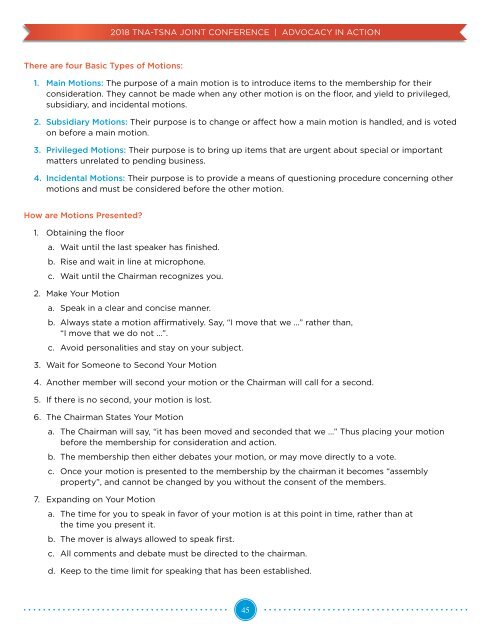2018 TNA and TSNA Joint Annual Conference
You also want an ePaper? Increase the reach of your titles
YUMPU automatically turns print PDFs into web optimized ePapers that Google loves.
<strong>2018</strong> <strong>TNA</strong>-<strong>TSNA</strong> JOINT CONFERENCE | ADVOCACY IN ACTION<br />
There are four Basic Types of Motions:<br />
1. Main Motions: The purpose of a main motion is to introduce items to the membership for their<br />
consideration. They cannot be made when any other motion is on the floor, <strong>and</strong> yield to privileged,<br />
subsidiary, <strong>and</strong> incidental motions.<br />
2. Subsidiary Motions: Their purpose is to change or affect how a main motion is h<strong>and</strong>led, <strong>and</strong> is voted<br />
on before a main motion.<br />
3. Privileged Motions: Their purpose is to bring up items that are urgent about special or important<br />
matters unrelated to pending business.<br />
4. Incidental Motions: Their purpose is to provide a means of questioning procedure concerning other<br />
motions <strong>and</strong> must be considered before the other motion.<br />
How are Motions Presented?<br />
1. Obtaining the floor<br />
a. Wait until the last speaker has finished.<br />
b. Rise <strong>and</strong> wait in line at microphone.<br />
c. Wait until the Chairman recognizes you.<br />
2. Make Your Motion<br />
a. Speak in a clear <strong>and</strong> concise manner.<br />
b. Always state a motion affirmatively. Say, “I move that we ...” rather than,<br />
“I move that we do not ...”.<br />
c. Avoid personalities <strong>and</strong> stay on your subject.<br />
3. Wait for Someone to Second Your Motion<br />
4. Another member will second your motion or the Chairman will call for a second.<br />
5. If there is no second, your motion is lost.<br />
6. The Chairman States Your Motion<br />
a. The Chairman will say, “it has been moved <strong>and</strong> seconded that we ...” Thus placing your motion<br />
before the membership for consideration <strong>and</strong> action.<br />
b. The membership then either debates your motion, or may move directly to a vote.<br />
c. Once your motion is presented to the membership by the chairman it becomes “assembly<br />
property”, <strong>and</strong> cannot be changed by you without the consent of the members.<br />
7. Exp<strong>and</strong>ing on Your Motion<br />
a. The time for you to speak in favor of your motion is at this point in time, rather than at<br />
the time you present it.<br />
b. The mover is always allowed to speak first.<br />
c. All comments <strong>and</strong> debate must be directed to the chairman.<br />
d. Keep to the time limit for speaking that has been established.<br />
45

















